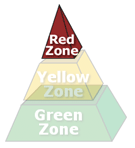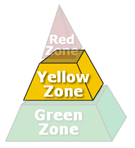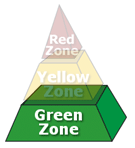|
OSHA/NIOSH Interim Guidance - April 1, 2005
Chemical - Biological - Radiological - Nuclear (CBRN)
Personal Protective Equipment Selection Matrix
for Emergency Responders |
|
|
|
NOTICE |
| This product is not a standard or regulation,
and it has no effect on employers' legal obligations. The guidance is advisory in nature,
informational in content, and is intended only as technical assistance to employers in providing a safe
and healthful workplace during emergency response operations. This document does
not enhance or diminish any existing obligations under the OSH Act. The
information in this document is interim guidance only. It is anticipated that NIOSH CBRN
approval for all classes of respirators will be available in the near future. This guidance will change at the time NIOSH CBRN certification standards are available for all respirator classes.
OSHA also may update this guidance as additional information becomes available
in the future. |
Introduction
Recent terrorist events in the United States underscore the importance of emergency response procedures for dealing with terrorist-related events involving chemical, biological, radiological, or nuclear (CBRN)
agents. OSHA and NIOSH continue to work with other Federal response agencies to provide accurate, current information to help prepare these on-scene responders.
Personal Protective Equipment (PPE) for CBRN Response
Emergency response to hazardous substance releases including CBRN are guided under OSHA's Hazardous Waste Operations and Emergency Response (HAZWOPER) Standard (29 CFR 1910.120(q)). Personal protective equipment is selected to meet the requirements of this standard and Subpart I. NIOSH has developed a
respiratory protection approval specifically for CBRN exposures
and the Department of Homeland Security also adopted
guidelines for appropriate PPE. In order to use this guidance effectively, an employer must assess the risk of a hazardous substance release to the emergency responders and base the PPE selection on the level of knowledge
relative to that risk. This kind of assessment is a typical safety and health evaluation with the unusual caveats that many of the agents are highly toxic by both skin and inhalation, typical indicators of exposure such as odor, smoke, or fume may not be present, exposure monitoring is difficult for some of the compounds, and there may be a locally limited supply of CBRN-approved respirators for a large response during initial emergency operations. Based on the hazardous substances and conditions known to be present, the Incident Commander in charge of a response shall implement appropriate emergency operations, including selection of appropriate PPE for employees who respond. This includes, at a minimum, PPE meeting the criteria in
29 CFR 1910.156(e)
for fire fighting operations beyond the incipient stage,
29 CFR 1910.120(q)(3)(iii).
Site Control
Site control is an important part of managing any emergency response operation. Some guidance for zoning exists
in
29 CFR 1910.120 Appendix C
and in the
NFPA 471 Standard (2002) (Hot, Warm, Cold) with hot denoting a
contaminated area where adverse effects might be seen, warm being an initially clean area for close support and decon, and cold
representing an area with no potential exposure. Other guidance from the
DOT Emergency Response Guidebook (2004) provides for an "Initial Isolation Zone" where dangerous or life threatening concentrations of a substance may exist or a "Protective Action Zone" where serious or irreversible health effects may be seen. The OSHA zones of Red, Yellow, and Green described below are available to be used by incident commanders as complimentary guidance for personal protective equipment selection based on the level of knowledge about the WMD events. The use of the Red, Yellow, and Green zones is not mandatory nor exclusionary of other site control concepts. It is intended to offer flexibility to an incident commander managing a large WMD event within the limitations of current first responder monitoring
capabilities.
 RED ZONE
Areas where significant contamination with chemical, biological, radiological, or nuclear (CBRN) agents has been confirmed or is strongly suspected but area has not been characterized. The Area is presumed to be life threatening from both skin contact and inhalation.
Level A protection is generally needed when the active release is still occurring, or the release has stopped but there is no information about the duration of the release or the airborne concentrations of CBRN agents. Respirators chosen initially for responders going into a known release area where CBRN are suspected should be a positive pressure self contained breathing apparatus (SCBA) with a fully encapsulating protective suit until monitoring results allow for other decisions. Level A protection should be consistent with the description in HAZWOPER Appendix B and suits should be appropriate for CBRN agents. e.g. meets the requirements of
NFPA
1994-2001, has been tested by a third party such as the U.S. Army and Soldier and Biological Chemical Command (SBCCOM), or has undergone other manufacturer testing. A
NIOSH-certified CBRN SCBA respirator should be used, if available.
RED ZONE
Areas where significant contamination with chemical, biological, radiological, or nuclear (CBRN) agents has been confirmed or is strongly suspected but area has not been characterized. The Area is presumed to be life threatening from both skin contact and inhalation.
Level A protection is generally needed when the active release is still occurring, or the release has stopped but there is no information about the duration of the release or the airborne concentrations of CBRN agents. Respirators chosen initially for responders going into a known release area where CBRN are suspected should be a positive pressure self contained breathing apparatus (SCBA) with a fully encapsulating protective suit until monitoring results allow for other decisions. Level A protection should be consistent with the description in HAZWOPER Appendix B and suits should be appropriate for CBRN agents. e.g. meets the requirements of
NFPA
1994-2001, has been tested by a third party such as the U.S. Army and Soldier and Biological Chemical Command (SBCCOM), or has undergone other manufacturer testing. A
NIOSH-certified CBRN SCBA respirator should be used, if available.
Other prudent work practices should include minimizing exposure time to that essential for lifesaving or initial monitoring, avoiding any unnecessary contact with surfaces or potentially contaminated material, use of natural ventilation flows to reduce exposure, mandatory decontamination and post exit evaluation for signs and symptoms of exposure.
 YELLOW ZONE
Areas where contamination with chemical, biological, radiological, or nuclear (CBRN) agents is possible but active release has ended and initial monitoring exists.
Areas in close proximity to the release area or that are known to be contaminated and certain job activities on the periphery of the event area should be considered for this zone. Risk factors that should be considered include determining the relative risk for job activities from inhalation based on available air monitoring results, skin contact and absorption potential, proximity to the event, and wind directions. Refer to the specific hazard information pages below to select personal protective equipment and limited work durations to reduce exposure to safe levels. Use
the other prudent work practices listed above for red zone exposures.
YELLOW ZONE
Areas where contamination with chemical, biological, radiological, or nuclear (CBRN) agents is possible but active release has ended and initial monitoring exists.
Areas in close proximity to the release area or that are known to be contaminated and certain job activities on the periphery of the event area should be considered for this zone. Risk factors that should be considered include determining the relative risk for job activities from inhalation based on available air monitoring results, skin contact and absorption potential, proximity to the event, and wind directions. Refer to the specific hazard information pages below to select personal protective equipment and limited work durations to reduce exposure to safe levels. Use
the other prudent work practices listed above for red zone exposures.
 GREEN ZONE Areas where contamination with chemical, biological, radiological, or nuclear (CBRN) agents is unlikely. This zone covers the area beyond the expected significant dispersal range of the initial event and secondary contamination range caused by traffic and emergency responders.
Even in areas which are not thought to pose a hazard,
there may be a concern or potential for a minimal level of transient or unknown
exposures in the aftermath of an event. The following suggestions for prudent
work practices may reduce the amount of concern regarding this potential:
GREEN ZONE Areas where contamination with chemical, biological, radiological, or nuclear (CBRN) agents is unlikely. This zone covers the area beyond the expected significant dispersal range of the initial event and secondary contamination range caused by traffic and emergency responders.
Even in areas which are not thought to pose a hazard,
there may be a concern or potential for a minimal level of transient or unknown
exposures in the aftermath of an event. The following suggestions for prudent
work practices may reduce the amount of concern regarding this potential:
- Inform people of location of event and control zones.
- Provide information regarding signs and symptoms of exposure.
- Suggest a means for reporting suspected exposures.
- Suggest attention to general hygiene practices.
- Provide information on voluntary use of personal protective equipment.
Specific Hazard Information
Related Online Resources
|
|

